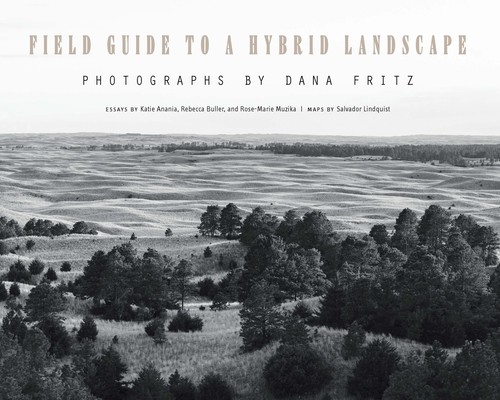
- We will send in 10–14 business days.
- Author: Dana Fritz
- Publisher: BISON BOOKS
- ISBN-10: 1496227778
- ISBN-13: 9781496227775
- Format: 25.2 x 20.2 x 1.4 cm, minkšti viršeliai
- Language: English
- SAVE -10% with code: EXTRA
Reviews
Description
In Field Guide to a Hybrid Landscape Dana Fritz traces the evolution of the Bessey Ranger District and Nursery of the Nebraska National Forest and Grasslands. Fritz's contemporary photographs of this unique ecosystem, with provocative environmental essays, maps, and historical photographs from the U.S. Forest Service archives, illuminate the complex environmental and natural history of the site, especially as it relates to built environments, land use, and climate change.
The Nebraska National Forest at Halsey, as it is known colloquially, is the largest hand-planted forest in the Western Hemisphere, and formerly in the world. This hybrid landscape of a conifer forest overlaid onto a semiarid grassland just west of the one-hundredth meridian was an ambitious late nineteenth-century idea to create a timber industry, to reclaim a landscape considered disordered and unproductive, and to change the local climate in northcentral Nebraska. While the planners seemed not to appreciate the native grasslands that form the ecosystem of the Nebraska Sandhills, they did recognize the reliable water from the Dismal and Middle Loup Rivers that border the site. In 1902 the first federal nursery was established as part of the Dismal River Forest Reserve to produce seedlings for plains homesteads and the adjacent treeless tract of land. At that time tree planting was not used for carbon sequestration but to mitigate the wind and evaporation of moisture. The Bessey Nursery now produces replacement seedlings for burned and beetle-damaged forests in the Rocky Mountains and for the Nebraska Conservation Trees Program. This constructed landscape of row-crop trees that were protected from fire for decades, yet never commercially harvested for timber, provides a rich metaphor for current environmental predicaments. The late nineteenth-century effort to reclaim with trees what was called the Great American Desert has evolved to a focus on twenty-first-century conservation, grassland restoration, and reforestation, all of which work to sequester carbon, maintain natural ecosystem balance, and mitigate large-scale climate change. Field Guide to a Hybrid Landscape offers a visual and critical examination of this unique managed landscape, which has implications far beyond its borders.EXTRA 10 % discount with code: EXTRA
The promotion ends in 22d.04:35:17
The discount code is valid when purchasing from 10 €. Discounts do not stack.
- Author: Dana Fritz
- Publisher: BISON BOOKS
- ISBN-10: 1496227778
- ISBN-13: 9781496227775
- Format: 25.2 x 20.2 x 1.4 cm, minkšti viršeliai
- Language: English English
In Field Guide to a Hybrid Landscape Dana Fritz traces the evolution of the Bessey Ranger District and Nursery of the Nebraska National Forest and Grasslands. Fritz's contemporary photographs of this unique ecosystem, with provocative environmental essays, maps, and historical photographs from the U.S. Forest Service archives, illuminate the complex environmental and natural history of the site, especially as it relates to built environments, land use, and climate change.
The Nebraska National Forest at Halsey, as it is known colloquially, is the largest hand-planted forest in the Western Hemisphere, and formerly in the world. This hybrid landscape of a conifer forest overlaid onto a semiarid grassland just west of the one-hundredth meridian was an ambitious late nineteenth-century idea to create a timber industry, to reclaim a landscape considered disordered and unproductive, and to change the local climate in northcentral Nebraska. While the planners seemed not to appreciate the native grasslands that form the ecosystem of the Nebraska Sandhills, they did recognize the reliable water from the Dismal and Middle Loup Rivers that border the site. In 1902 the first federal nursery was established as part of the Dismal River Forest Reserve to produce seedlings for plains homesteads and the adjacent treeless tract of land. At that time tree planting was not used for carbon sequestration but to mitigate the wind and evaporation of moisture. The Bessey Nursery now produces replacement seedlings for burned and beetle-damaged forests in the Rocky Mountains and for the Nebraska Conservation Trees Program. This constructed landscape of row-crop trees that were protected from fire for decades, yet never commercially harvested for timber, provides a rich metaphor for current environmental predicaments. The late nineteenth-century effort to reclaim with trees what was called the Great American Desert has evolved to a focus on twenty-first-century conservation, grassland restoration, and reforestation, all of which work to sequester carbon, maintain natural ecosystem balance, and mitigate large-scale climate change. Field Guide to a Hybrid Landscape offers a visual and critical examination of this unique managed landscape, which has implications far beyond its borders.

Reviews